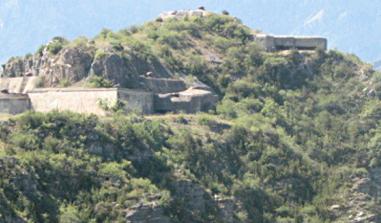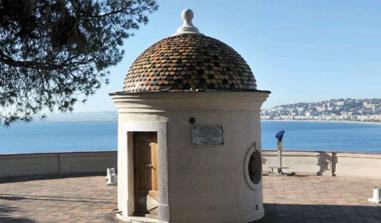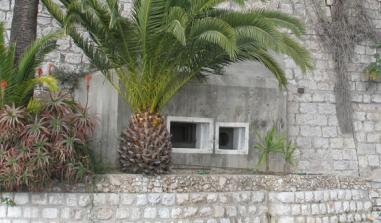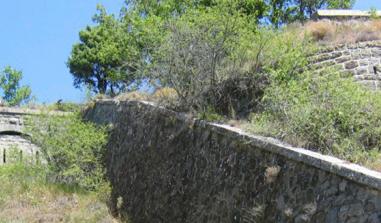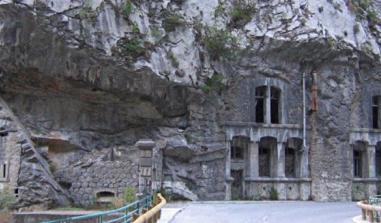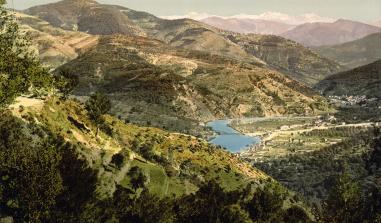Fort de Sainte-Agnès

Outside view of the fort. Author: Berthold Werner
Fort de Ste-Agnès, an underground structure on the Maginot Line, was designed to defend the border between France and Italy.
Fort de Sainte-Agnès, a structure in the Fortified Sector of the Alpes Maritimes on the Maginot Line, was built between 1932 and 1938 and is completely underground. Its purpose was to defend the border between France and Italy. The village of Sainte-Agnès, the highest coastal village in Europe, clutches to the side of a 780-metre peak overlooking the Mediterranean Sea. This advantage led the local lords to use it as a fortress starting in the 16th century. Thus, as a privileged observation and defence position, the construction of the Maginot structure at Sainte-Agnès was part of the military programme for the Fortified Sector of the Alpes Maritimes (SFAM).
Sainte-Agnès is located on a rocky outcropping overlooking the sea at nearly 800 metres. During the Roman period, the site was semi-permanently occupied by shepherds and peasants. The discovery of a church consecrated to Saint Agnès, martyr under the reign of Diocletian, has made it possible to date the founding of the town to the beginning of the 12th century, when it belonged to the Count of Ventimiglia. A strategically important location for the Counts of Provence and the Genoese, the site was fortified at the end of the 14th century by the House of Savoy. The scene of battles between French troops and the Sardinians, the fortress became a possession of the Kingdom of Piedmont-Sardinia between 1814 and 1860, when the County of Nice and Savoy were attached to France.
The fort, built between 1932 and 1938 to defend the Bay of Menton against Italian attacks, is completely underground. With 2,000 m² of galleries and rooms, it was dug into over 55 metres of rock. Exclusively defensive, with powerful artillery blocks, it was one of the most powerful structures in the Fortified Sector of the Alpes Maritimes. Designed to be completely autonomous, the Fort de Sainte-Agnès is a veritable “underground city”.
The fort has also kept its artillery in a bunker (135 and 75-mm Howitzer cannons, 81-mm mortar). The south block (or block 2), the most powerfully armed front bunker of the entire Maginot Line (75 mm, 81 mm and 135 mm cannons), held off the Italian offensive of June 1940, with a barrage of artillery blocking the coast and forcing the Italian troops to retreat.
The fort was owned by the State until 1990. The municipality of Sainte-Agnès then acquired it to open it to the public and to preserve the memory of the site.
Town Hall
102 Place Saint Jean 06500 Sainte Agnès
Tel.: +33 (0)4 93 35 84 58
Fax: +33 (0)4 92 10 35 14
Opening hours: Week-ends from 2.00 pm to 5.30 pm. From July to September (closed Mondays) from 3.00 pm to 6.00 pm.
Admission (guided tours): Adults: €3.05 Children: €1.52 Groups (booked in advance): €2.29
Access: Coach Station – Regular service between Menton and Sainte-Agnès Tel.: +33 (0)4 93 35 73 51
Departure from the Menton coach station: every day at 9.50 am, 2.00 pm and 4.15 pm. An additional shuttle on Tuesdays and Saturdays at 8.00 am, 11.30 am, 1.00 pm and 5.15 pm.
Departure from Sainte-Agnès: every day at 10.20 am, 2.35 pm and 4.45 pm. An additional shuttle on Tuesdays and Saturdays at 8.30 am, 12.00 pm, 1.30 pm and 5.45 pm.
A8 motorway: Menton exit, the N 7 highway: seaside road, then follow the itinerary through the Valley du Borrigo or the Corniche des Serres de la Madone

Reconstitution de la vie quotidienne à l'intérieur du fort. Source : www.sainteagnes.fr

Mortier de 75 mm 1931. Source : www.sentinelles-des-alpes.com
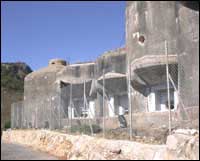
Vue extérieur du fort. Source : www.sainteagnes.fr
Practical information
6500
Sainte Agnès
04 93 35 84 58
Adultes: 5 € Enfants: 2 € Groupe: 3 €
Le weekend: de 14h à 17h30 De juillet à septembre (sauf le lundi): de 15h à 18h
25 décembre et 1° janvier



